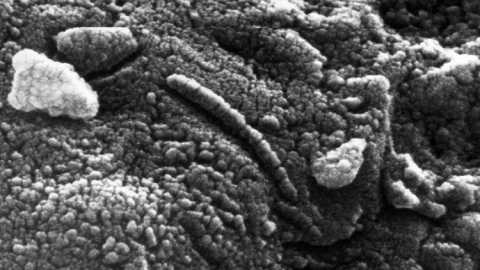Mars 2020 will hunt for ‘microfossils’, signs of ancient alien life

NASA
- The Jerezo crater is likely home to hydrated silica, a material which on Earth is especially good at preserving signs of life.
- Mars 2020 is set to land on the planet crater in February 2021. NASA’s Curiosity rover is currently the only rover operating on Mars.
- The discovery of past life on Mars would be revolutionary, at least in science and philosophy.
The Mars 2020 rover is set to search for signs of past alien life when it lands on the red planet in 2021.
NASA hopes to land the rover on Mars’ Jerezo crater, a site which — according to recent observations from the Mars Reconnaissance Orbiter — is likely home to hydrated silica, a mineral known to preserve signs of life on Earth. A paper recently published in the journal Geophysical Research Letters describes how this material might contain biosignatures left behind by tiny alien lifeforms billions of years ago. In short, it’s a fossil hunt — a microfossil hunt, more precisely.
“The oldest evidence — definitive evidence — of microfossils that we have on Earth are usually found in silica,” Jesse Tarnas, a planetary scientist at Brown University and one of the authors of the paper, told Astronomy.

NASA
Today, Mars is essentially a vast desert with a thin atmosphere that — according to almost all scientists — cannot support life. But it’s possible that the red planet supported life a few billion years ago, during the Noachian period. There’s evidence, for example, suggesting that rivers raged on Mars within the past billion years (liquid water is believed to be necessary for all lifeforms).

NASA
Some of these rivers used to flow through the part of Mars that is now Jerezo crater, and they carved a delta into the planet’s surface. It’s here that Mars 2020 might find hydrated silica, a crystalline material that might have formed in the delta, or elsewhere on the planet (volcanoes, for example), from which it was carried to the delta by rivers.

NASA
Mars 2020 will be able to analyze any hydrated silica it finds. But to confirm the existence of biosignatures within that material, the rover will need to take samples to be brought back to Earth so scientists can analyze them in the lab. However, it’s possible that some rocks on Mars contain fossils large enough for the rover to photograph.
In addition to searching for microfossils, Mars 2020 will help scientists learn more about the planet’s surface and future landing sites, and it will also bring samples of spacesuits to the planet so scientists can study how the materials degrade when subjected to the Martian environment.
What would the discovery of life on Mars mean?
Finding signs of life on Mars would finally settle the longstanding question: Is Earth the only planet capable of supporting life? If Mars 2020 does find biosignatures on Earth’s neighbor, it would suggest that life almost surely exists throughout the universe. The discovery would be revolutionary, at least in science and philosophy.
“I think such a discovery would be momentous, more momentous than the Copernican Revolution, but philosophically very similar,” David Weintraub, a professor of astronomy at Vanderbilt University, told Gizmodo. “Pre-Copernicus, most thinkers — whether for religious or philosophical or metaphysical reasons — accepted that Earth was the center of the universe and thus that we were likely the center of creation and of God’s attention… Copernicus de-centered humanity. The discovery of life beyond the Earth will, similarly, decenter humanity. Life on Earth would no longer be unique. Honestly, I can’t think of a more momentous discovery.”
Yet, the discovery of life on Mars probably wouldn’t change day-to-day life much, or send our belief systems and social institutions into chaos. After all, the world has already been through a test run of the “alien life” announcement: In 1996 researchers from NASA’s Johnson Space Center published claims suggesting that a Martian meteorite called Allan Hills 84001 contained microfossils. Skeptics later noted that these supposed biosignatures likely came from inorganic processes. But throughout that process, the public’s reaction seemed to be slightly-more-than-normal interest in the news story.





